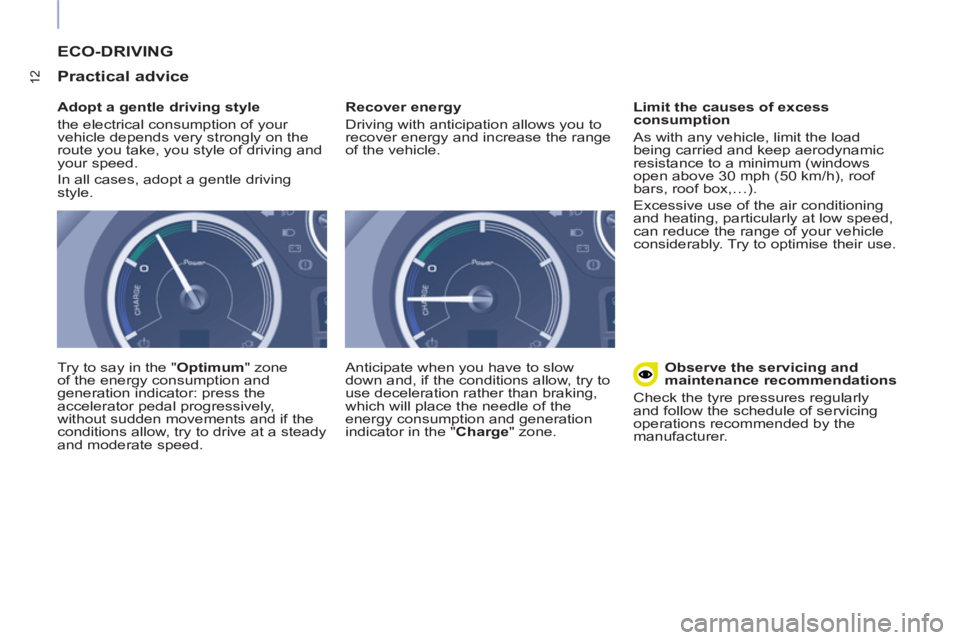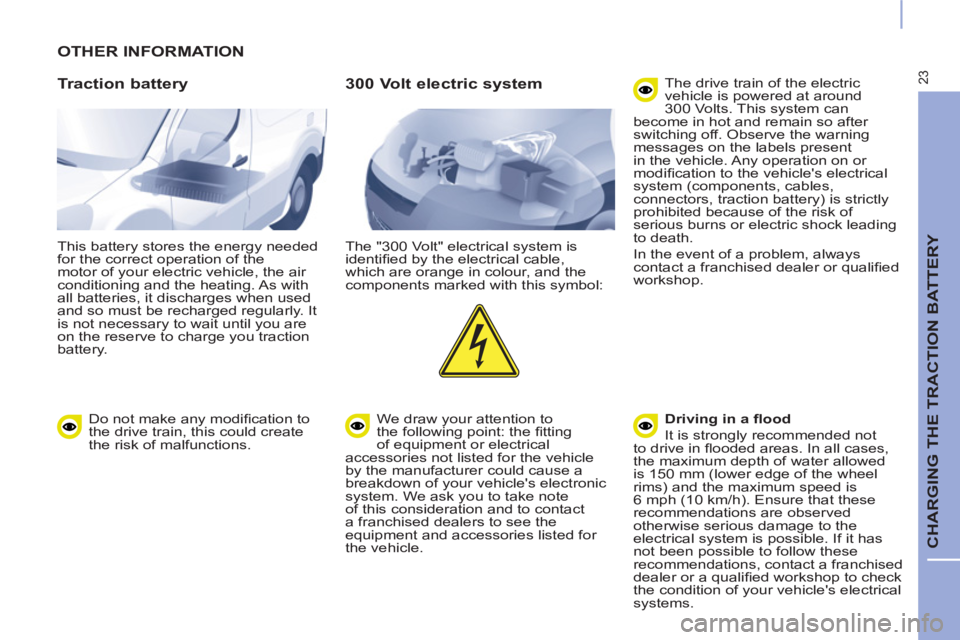Page 266 of 328
8
Heating and air conditioning systems energy consumption indicator
The consumption of electrical
energy related to the heating and
air conditioning is represented by
this gauge. Excessive use, particularly at low
speed, can reduce the range of
your vehicle considerably.
Remember to optimise their use and
check their settings at each start so as
to maximise the range of the vehicle.
Page 267 of 328

9
INSTRUMENTS AND CONTROLS
WARNING AND INDICATOR LAMPS
Lamp
State
Cause
Actions / Observations
Ready
On,
accompanied
by an audible
signal when it
comes on. The vehicle is ready to drive. The lamp is on while the vehicle is
powered up.
You can press the accelerator and
use the air conditioning or heating.
Reserve
On,
accompanied
by an audible
signal. The state of charge of the
traction battery is low. Check the range remaining.
Put the vehicle on charge as soon
as possible.
Protection of the
traction battery
On,
accompanied
by a regular
audible signal. The state of charge of the
traction battery is critical. When the state of charge of the
battery is low, reduction of motor
power is progressive progressive.
You must put the vehicle on charge.
On. Maximum motor power is not
available. If the warning lamp does not go
off, contact a dealer or a qualifi ed
workshop.
Traction
battery
charge
On. The traction battery is on
charge. The lamp goes out once charging
is complete .
Flashing. The vehicle cannot be started
as the charging cable is still
connected to the vehicle's
socket. Check the charging cable
connection.
Disconnect the charging cable.
Auto-diagnosis
of the main
electrical system
On. Fault detected in the main
electric system. Have it checked by a dealer or
qualifi ed workshop as soon as
possible.
Incident in the
drive train
On.
You must stop as soon as it is safe to do so.
Have it checked by a dealer or qualifi ed
workshop as soon as possible.
Page 268 of 328
10
DISPLAY SCREENS
Screen (depending on
equipment level)
Each press of the button on the end
of the windscreen wiper stalk displays
successively the different trip computer
information, depending on the type of
screen.
Setting the units
Range
It displays:
- the estimated range remaining,
- the additional range available
by using the ECO
mode on the
heating and air conditioning control
panel,
- the additional range after stopping
the heating and air conditioning.
They display:
- a trip distance recorder (choice of
trip 1 or 2),
- the average energy consumption from
the battery (over 62 miles (100 km)),
- the speed.
Trips (1 and 2)
This screen displays an estimate of the
number of miles or kilometres driving
range before the battery has to be
charged.
Instrument panel
Page 270 of 328

12
ECO-DRIVING
Practical advice
Adopt a gentle driving style
the electrical consumption of your
vehicle depends very strongly on the
route you take, you style of driving and
your speed.
In all cases, adopt a gentle driving
style.
Try to say in the " Optimum
" zone
of the energy consumption and
generation indicator: press the
accelerator pedal progressively,
without sudden movements and if the
conditions allow, try to drive at a steady
and moderate speed.
Recover energy
Driving with anticipation allows you to
recover energy and increase the range
of the vehicle.
Anticipate when you have to slow
down and, if the conditions allow, try to
use deceleration rather than braking,
which will place the needle of the
energy consumption and generation
indicator in the " Charge
" zone.
Limit the causes of excess
consumption
As with any vehicle, limit the load
being carried and keep aerodynamic
resistance to a minimum (windows
open above 30 mph (50 km/h), roof
bars, roof box,…).
Excessive use of the air conditioning
and heating, particularly at low speed,
can reduce the range of your vehicle
considerably. Try to optimise their use.
Observe the servicing and
maintenance recommendations
Check the tyre pressures regularly
and follow the schedule of servicing
operations recommended by the
manufacturer.
Page 271 of 328
13
ECO-COMFORT
ECO-COMFORT
Control the use of electrical
equipment
The heating and air conditioning
operate using energy supplied by
the traction battery. Excessive use
signifi cantly reduces the range of your
vehicle. Try to optimise their use as
soon as you reached the desired level
of comfort and check the settings at
every start in order to maximise range.
Also limit the use of demisting and
defrosting and of the heated seat.
Stop the heating or air
conditioning and maintain
ventilation.
Stop the heating or air
conditioning and ventilation.
Pressing the ECO
button stops
the heating and air conditioning
(but maintains ventilation). The
needle of the energy consumption and
generation indicator is placed in the
ECO
zone.
Operating the temperature
control activates the heating
or air conditioning and
stops ECO
mode.
Page 272 of 328

14
MANUAL AIR CONDITIONING AND HEATING
ECO
(stops the air conditioning
and heating).
OFF
(stops the heating, air
conditioning and ventilation).
Windscreen demist.
Rear screen demist on
versions with glazed rear
doors.
Air distribution.
Recirculation of interior air/
Intake of exterior air.
Increase/Reduce air fl ow.
Increase/Reduce temperature.
Ventilation can be used as
soon as this indicator is on.
After a prolonged period without
use of the heating system, its
operation may result in a slight
odour during the fi rst few minutes
of use.
Special features of the air
conditioning and heating
The air conditioning and heating
systems do not regulate the
temperature in the cabin directly, but
ensure a constant temperature at the
fan-fed air vents (a temperature which
is indexed to the level of hot or cold
desired by the users).
if you want to rapidly heat or cool the
vehicle cabin, you can temporarily set
the temperature control to maximum
hot or cold.
It should be noted however that:
- The air conditioning system
(cooling of the air) only operates
when the ambient temperature is
above 15°C,
- The power of the heating system
is progressively restricted when
the ambient temperature is above
20°C.
Manual heating version
Practical advice
Heating and ventilation
In winter, air distribution
towards the footwells is
recommended, allowing a
more uniform ambience to be
obtained in the cabin.
In summer, distribution towards the
face-level vents will increase the
effectiveness of the ventilation and air
conditioning.
In heating mode, try to use
moderate level of ventilation,
that is less than 3 blades. This
will allow the system to deliver
air at a higher temperature.
Air distribution
Page 281 of 328

23
CHARGING THE TRACTION BATTERY
OTHER INFORMATION
Traction battery
This battery stores the energy needed
for the correct operation of the
motor of your electric vehicle, the air
conditioning and the heating. As with
all batteries, it discharges when used
and so must be recharged regularly. It
is not necessary to wait until you are
on the reserve to charge you traction
battery.
300 Volt electric system
The "300 Volt" electrical system is
identifi ed by the electrical cable,
which are orange in colour, and the
components marked with this symbol:
We draw your attention to
the following point: the fi tting
of equipment or electrical
accessories not listed for the vehicle
by the manufacturer could cause a
breakdown of your vehicle's electronic
system. We ask you to take note
of this consideration and to contact
a franchised dealers to see the
equipment and accessories listed for
the vehicle. The drive train of the electric
vehicle is powered at around
300 Volts. This system can
become in hot and remain so after
switching off. Observe the warning
messages on the labels present
in the vehicle. Any operation on or
modifi cation to the vehicle's electrical
system (components, cables,
connectors, traction battery) is strictly
prohibited because of the risk of
serious burns or electric shock leading
to death.
In the event of a problem, always
contact a franchised dealer or qualifi ed
workshop.
Driving in a fl ood
It is strongly recommended not
to drive in fl ooded areas. In all cases,
the maximum depth of water allowed
is 150 mm (lower edge of the wheel
rims) and the maximum speed is
6 mph (10 km/h). Ensure that these
recommendations are observed
otherwise serious damage to the
electrical system is possible. If it has
not been possible to follow these
recommendations, contact a franchised
dealer or a qualifi ed workshop to check
the condition of your vehicle's electrical
systems.
Do not make any modifi cation to
the drive train, this could create
the risk of malfunctions.
Page 289 of 328

31
SUPPLEMENT FOR ELECTRIC MODE
MOTOR AND TRACTION BATTERY
The range of the vehicle, approved on the NEDC cycle, is 170 km (105 miles). This range can vary according to
various factors, the main ones being the use of the heating and air conditioning, the style of driving, the type of route
taken and ageing of the traction battery.
Ageing of the traction battery also depends on various factors, such as the ambient temperature, the mileage of the vehicle,
the frequency of fast charges…
Electric motor
Technology
Synchronous with permanent magnets
Max. power in kilowatts: EU standard (kW)
49
Max. power speed in revolutions per minute (rpm)
from 4 000 to 9 200
Max. torque in Newton metres: EU standard (Nm)
200
Max. torque speed in revolutions per minute (rpm)
0 to 1 500
Traction battery
Technology
Lithium-Ion
Normal charge
Alternating current power supply in volts: (V) AC
230
Time for a complete charge (from 0% to 100%) according to the power supply
rating in Amps::
- 16 A
- 16 A
- 10 A
- 8 A
Depending on the power supply in the country.
Minimum time measured for ambient temperatures between 0
and 40°C.
7 hours 30 minutes
8 hours 30 minutes
12 hours
15 hours
Fast charge
Charging time (80% charge) from the reserve level
< 30 minutes